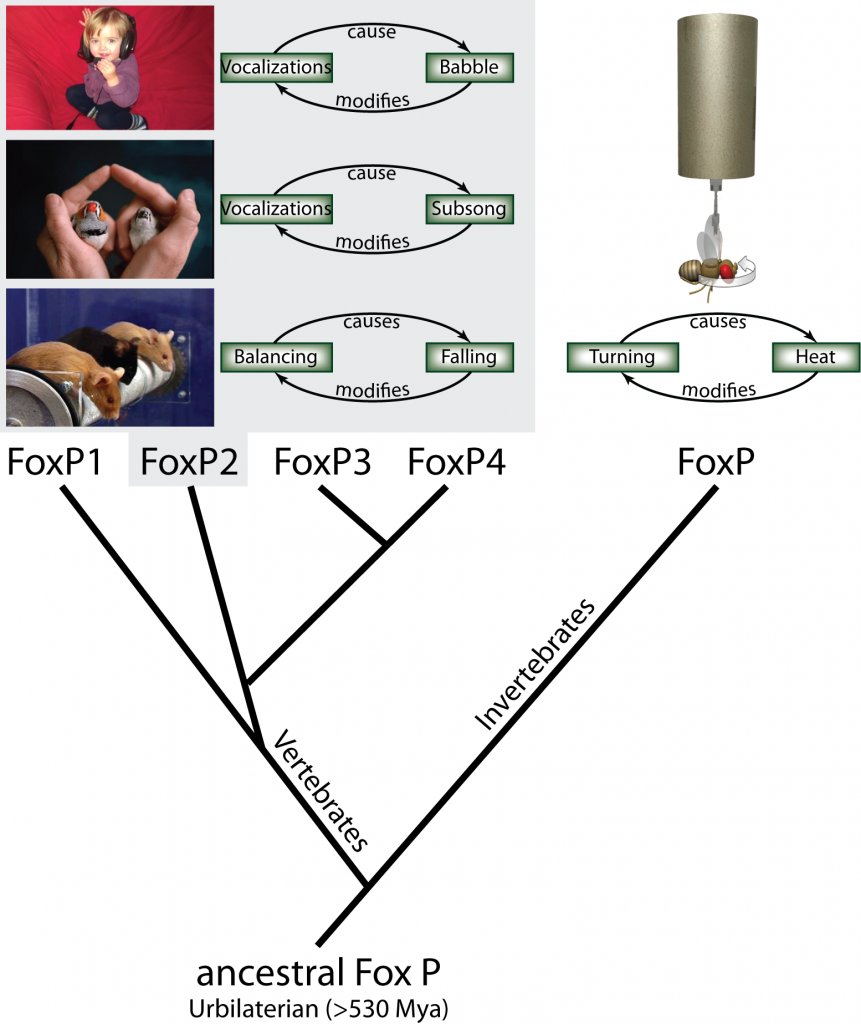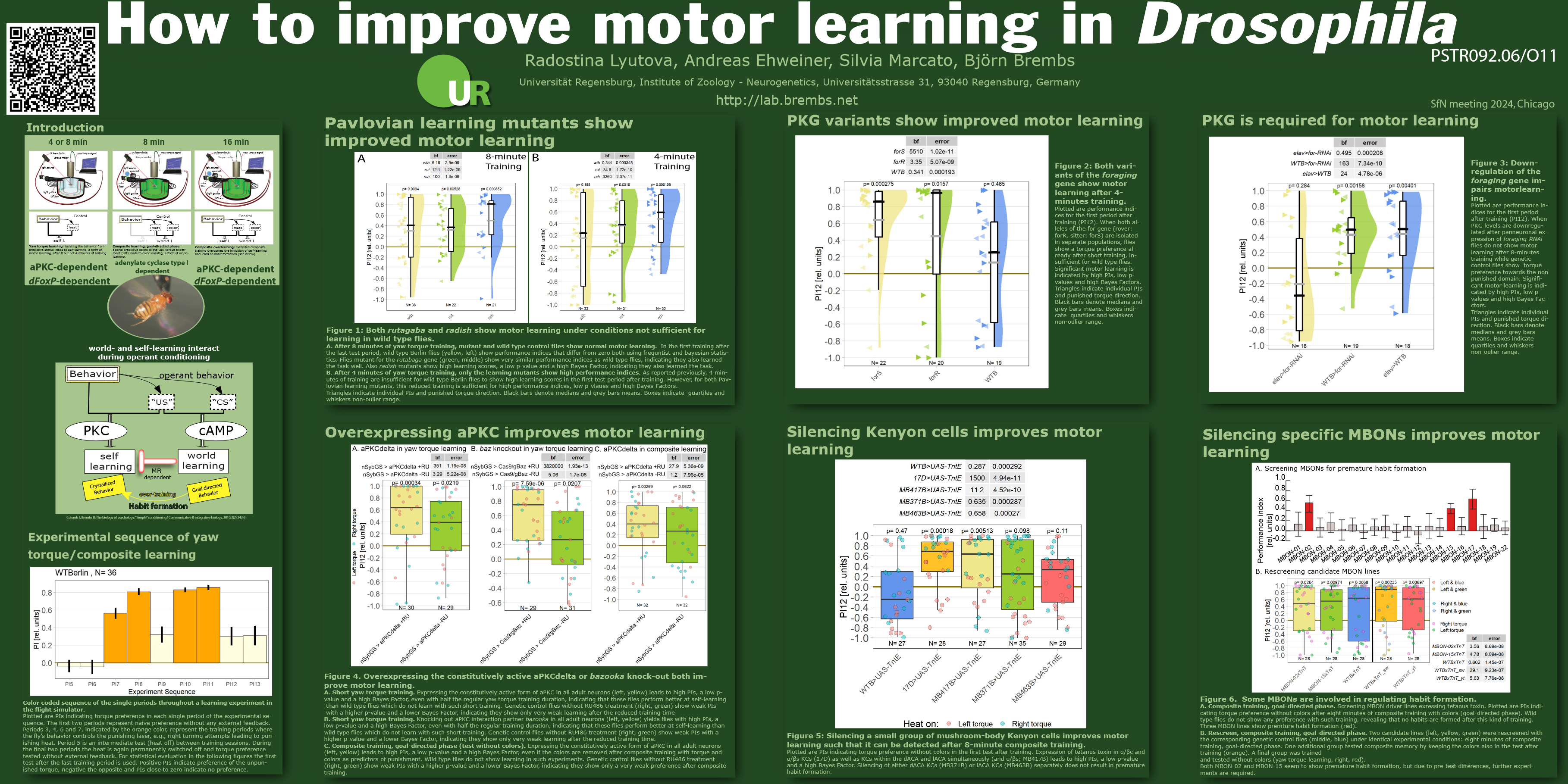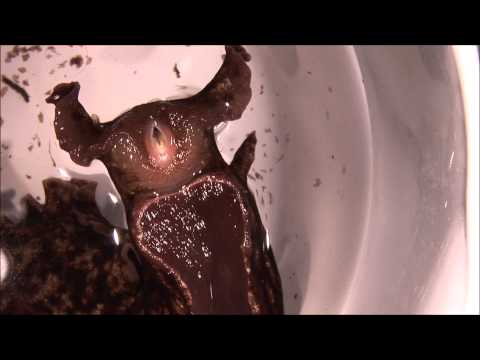See this post with the associated press releases on brembs.net.
The Forkhead Box P2 (FOXP2) gene is well-known for its involvement in language disorders. We have discovered that a relative of this gene in fruit flies, dFoxP, is necessary for a type of learning called operant self-learning, which resembles some aspects of language learning. This discovery traces one of the evolutionary roots of language back more than half a billion years before the first word was ever spoken. Intriguingly, dFoxP-function also differentiates between self and non-self, a key process malfunctioning in autism and schizophrenia disorders, in which FOXP2 has also recently been implicated. Finally, dFoxP is also important for habit formation, a common animal model for addiction.
Even though language is so much a part of what it means to be human, the evolution of this strikingly singular trait is still clouded in mystery. Genetic disorders with language impairments are a particularly effective route to uncovering the biological roots of language. Most prominently, one mutation in the FOXP2 gene appears to affect language acquisition in afflicted patients, without other obvious impairments (1). This gene is one of four members of the FoxP gene family which have evolved in vertebrate animals from a single ancestral FoxP gene by serial duplications. In invertebrates, these duplications never took place and thus the single currently existing invertebrate FoxP gene can serve as a model for studying the function of the extinct, ancestral gene (Fig. 1).

Fig. 1: Using operant conditioning to test invertebrate FoxP function. From the single ancestral FoxP gene, four different genes have evolved in the vertebrate lineage through serial duplications, while invertebrates have retained a single copy of the gene. In an operant feedback loop, spontaneous actions are followed by a given outcome as a consequence. Depending on that outcome being desirable or not, the frequency of the action increases or decreases in the future. For instance, vocalizations of a human infant are followed by the perception of the resulting babbling. The deviation from the intended articulation modifies future vocalizations until language is formed. Similarly, in songbirds, the perceived difference between the juvenile bird’s (right) own subsong and the memorized song from an adult tutor (left) modifies future vocalizations until the species-specific adult song is produced. In mice, balancing in the rotorod experiment is followed by eventual falling, which provides the feedback to improve subsequent balancing movements. All three examples have been shown to be dependent on normal FoxP2 function. Analogously, we have tested fly FoxP function by tethering flies and measuring their turning attempts in stationary flight. Some turning attempts (e.g. to the right) are followed by a punishing heat beam, others (e.g., to the left) are rewarded with turning the beam off. Continuous feedback modifies the fly’s turning attempts towards the direction where the heat is off.
Studies on FOXP2 patients revealed apraxia, i.e., the inability to articulate words and sentences, as one major symptom. Evidence from songbirds and transgenic mouse models seems to confirm the suspicion that the function of FoxP2 might be found in the speech component of language (1). More than fifty years ago, the behaviorist B.F. Skinner proposed that language might be acquired through an operant learning process (2): the first more or less random utterances (babbling) of infants are rewarded by their parents and correct utterances more so than incorrect ones. Moreover, just as imitating any movements, the ability to correctly imitate the words of others might be inherently rewarding. Eventually, the infant learns to correctly speak the words required to communicate their needs and affections.
Inspired by the possibility to test for one of the evolutionary roots of language in an invertebrate animal, we used a learning experiment in the fruit fly Drosophila which paralleled the operant concept proposed by Skinner: the tethered animals first produce more or less random behaviors (including turning attempts, left or right) and the experimenter rewards only designated ‘correct’ ones until the animal is spontaneously generating predominantly ‘correct’ behaviors (e.g. left turning attempts; Fig. 1). Importantly, we also used a control experiment, in which the animals’ behavior not only affected whether they would receive the reward or not, but also which color their environment was. Previous results had shown that in this control situation flies tend to learn more about the coloration of their environment than about their own behavior (3). If the function of dFoxP in flies were analogous to that of FOXP2 in humans, we would expect it to be necessary for the first experiment (‘operant self-learning’), but not for the second experiment (‘operant world-learning’).
Ever since Skinner’s proposal, these kinds of experiment had been discussed, but until now they have not been technically feasible. In his critique of Skinner’s proposition, the linguist Noam Chomsky dismissed the idea of operant experiments conceptually paralleling language acquisition as “mere homonyms, with at most a vague similarity of meaning” (4).
In order to be able to attribute any effect of our manipulations in the flies to the dFoxP gene, we used two different strategies. In the first, we tested flies with a mutation in the dFoxP gene in operant self- and world-learning. In the second we used the same two experiments to test flies in which we had experimentally targeted the dFoxP gene such that its expression was reduced. Both methods yielded essentially the same result: dFoxP is necessary for operant self-learning but not for operant world-learning, lending support to the hypothesis that operant self-learning may be one of the evolutionary ancestral capacities which had to exist in order for language to be able to evolve (i.e., an exaptation).
Another parallel between operant and language learning is the fact that prolonged practice leads to an automatization of the movements required. Only when a language is new do we need to think about the pronunciation and articulation of words and sentences. Once we are fluent, we only need to articulate our thoughts. Similarly, other movements can be trained with feedback until they become automated. Riding a bike, writing, tying shoe-laces, etc. are all examples of such automatic behaviors called skills or habits. If the learning mechanism for which dFoxP is required constitutes an exaptation for language acquisition and the speech component of language is a special form of a skill or a habit, then dFoxP mutant flies should be deficient in habit formation. To test this hypothesis, we used dFoxP mutant flies in a prolonged operant world-learning paradigm known to induce habits (5). Further corroborating our hypothesis, these mutant flies showed a severe deficit in habit formation.
In vertebrate animals, mutations in the FoxP2 gene leads to alterations in the brain structure of the affected individuals (1). This is thought to be due to the ability of FoxP genes to alter the expression of other genes, directly involved in brain development. To test if the fly dFoxP gene also is involved in brain development, we reconstructed the three-dimensional structure of the brains of flies with a mutated dFoxP gene in the computer. Using computer-assisted volume analysis, we discovered alterations in the fly brain structure which were too subtle to spot with the human eye, even at large magnifications. These results indicate that in flies as in vertebrate animals, FoxP genes may act as gene regulators during brain development.
Taken together our results provide evidence for a structural and functional conservation of FoxP genes since the split between vertebrate and invertebrate animals. This ‘deep’ homology spans vastly different brain organizations.
Source: Mendoza E, Colomb J, Rybak J Pflüger H-J, Zars T, Scharff C, Brembs B (2014): Drosophila FoxP mutants are deficient in operant self-learning. PLoS ONE: 10.1371/journal.pone.0100648
Raw data: Mendoza, E; Colomb, J; Rybak, J; Pflüger, H-J; Zars, T; Scharff, C; Brembs, B (2013): Drosophila FoxP molecular, anatomical and behavioral raw data. figshare. https://dx.doi.org/10.6084/m9.figshare.740444
REFERENCES.
- Bolhuis JJ, Okanoya K, Scharff C (2010) Twitter evolution: converging mechanisms in birdsong and human speech. Nature Reviews Neuroscience 11:747-759.
- Skinner BF (1957) Verbal Behavior (Copley Publishing Group).
- Brembs B, Plendl W (2008) Double dissociation of PKC and AC manipulations on operant and classical learning in Drosophila. Current Biology 18:1168-1171.
- Chomsky N (1959) A Review of B. F. Skinner’s Verbal Behavior. Language 35:26-58. Available at: https://cogprints.org/1148.
- Brembs B (2009) Mushroom bodies regulate habit formation in Drosophila. Current Biology 19:1351-5.
















Comments are closed.